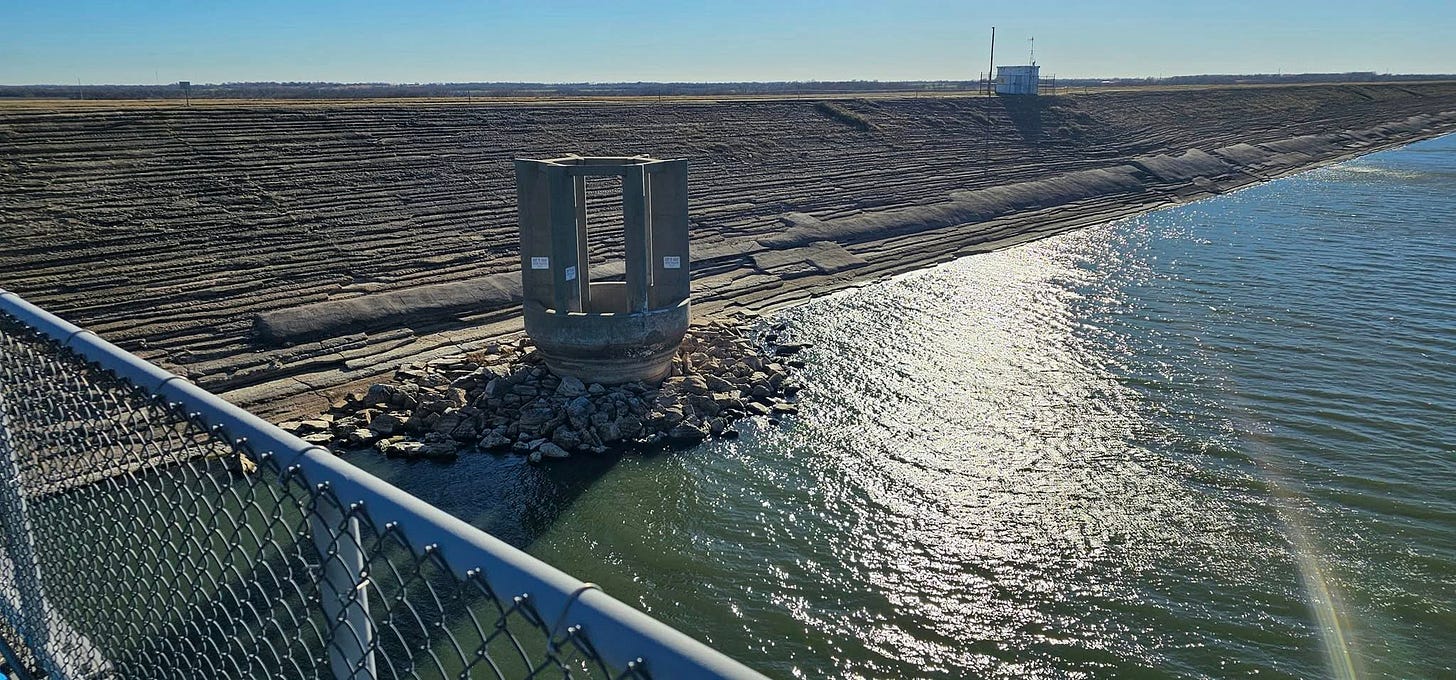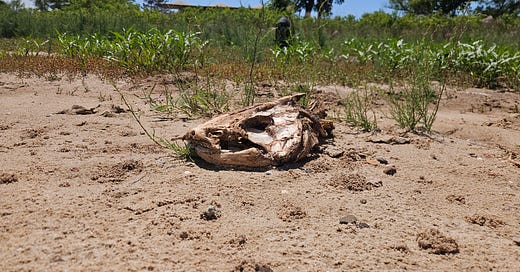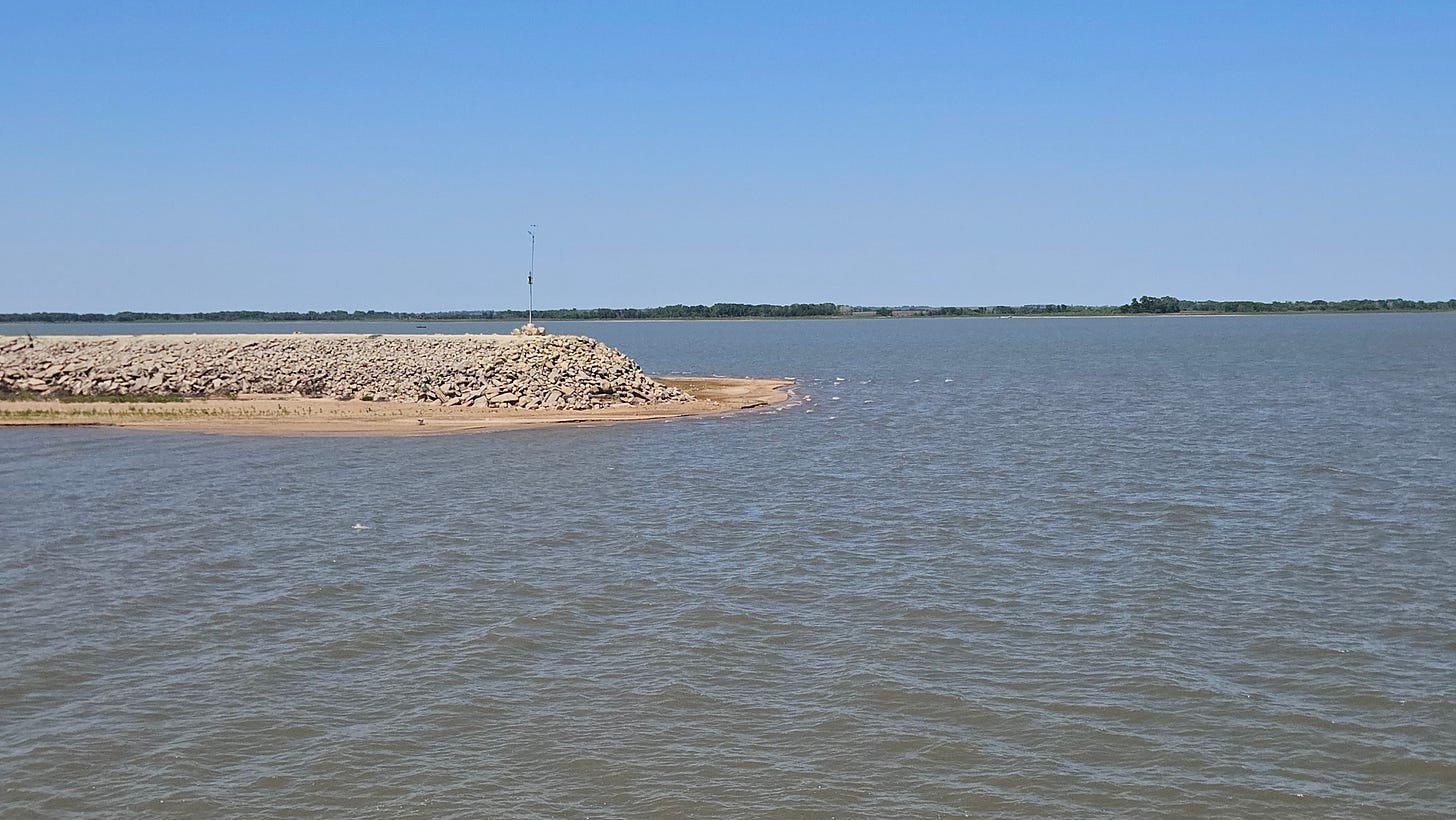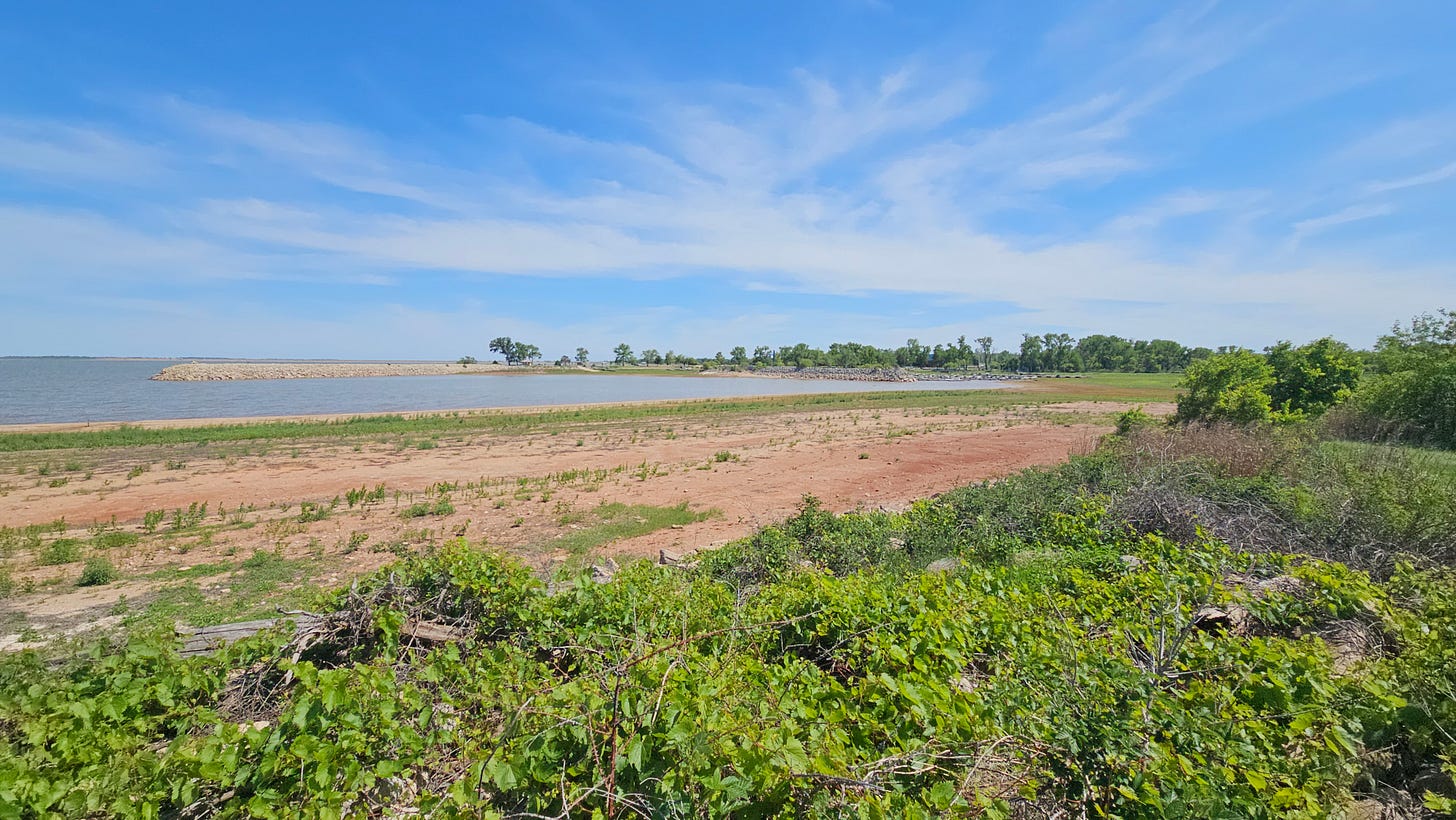Out here in the Wichita sprawl, where the Arkansas River dribbles like a half-hearted apology, we’re staring down a water crisis that feels like it snuck up on us while most people were too busy arguing over which barbecue sauce is better. Jug-hooters chafe at not being able to water their lawns, liberals chide their neighbors for running a hose on the wrong day. But the reality is far worse than level two restrictions or brown patches in the Bermuda. Sedgwick County, home to over half a million people, has been cruising towards catastrophe for decades.
Over 2000 permitted wells pump 57.7 billion gallons of water from the rapidly depleting Equus beds annually. Withdrawals exceed recharge to the point no new wells are being allowed in most of McPherson County (GMD2 Annual Report 2024). Much of the aquifer is pumped independently for agriculture and industry, but it’s also the main source for Wichita’s drinking water. Cheney Reservoir, our backup source, sits at a pathetic 57.54% capacity, gasping under the weight of drought and demand. Last weekend, I visited Cheney like I have for the last decade. This time, it was to document just how bad it is for this piece.

It’s tempting to blame climate change and shrug; to sink into the fatalism that whispers, “This is just how it is now.” Apathy is the real drought here, a parched mindset that lets us watch our water vanish while we mow our lawns and pretend it’ll all work out. Like Edward Abbey’s desert wanderers, we’re caught between awe at the land’s stark beauty and despair at our own inaction. But this isn’t a story of inevitable doom. It’s a call to shake off the dust of complacency, to fight for every drop, and to reimagine our future before Sedgwick County turns into a dustbowl rerun.
The History of Hydrologic Hubris
Sedgwick County’s water story is a classic American tale of engineering swagger and shortsightedness. Back in the 1940s, the Army Corps of Engineers, high on New Deal bravado, birthed Cheney Reservoir under the Flood Control Act of 1944. It was a middle finger to floods and a promise of endless water for Wichita’s growth. Fast forward to 1989, when a USGS study patted us on the back, saying our 126,100 acre-feet of public supply would hold until 2015, assuming we didn’t screw it up with unsustainable use or climate denial (Water supply and demand in Sedgwick County, Kansas, 1989). Spoiler: we kinda did. No new reservoirs have been built in 50 years, and the Kansas Water Plan of 2022 reads like a resigned shrug, focusing on squeezing blood from the stone of existing supplies. Our hydrologic engineering peaked when Eisenhower was president, and we’ve been coasting on that legacy ever since, like a band living off one hit from the ‘60s.
Drought, Demand, and Leadership That Slept Through 2015
Cheney Reservoir is drying up because Kansas is caught in a drought so brutal it makes Cormac McCarthy novels look cheerful. With 98.5% of the state parched, inflows to Cheney are a trickle, and Wichita’s pumping 44.5 million gallons daily like it’s still the wet ‘90s (Low Water Levels). Rainfall, averaging 34.49 inches from 1991-2020, has tanked in recent years, and 2024 was a masterclass in meteorological betrayal (Rainfall Data). Add a 2021 water main break that left 500,000 people boiling their tap water, and you’ve got a crisis that screams systemic failure (Boil Water Advisory).
Here’s the kicker: local and state leaders knew this was coming. That 1989 USGS study wasn’t a horoscope; it was a deadline. Yet, instead of building new reservoirs or curbing runaway water use, they kicked the can past 2015, betting on rain that never came without so much as a dance to go with it. Wichita’s city council and Topeka’s suits have been playing water roulette, prioritizing short-term optics over long-term survival. The Kansas Water Office, bless its bureaucratic heart, churns out plans that read like corporate wellness emails—vague, aspirational, and useless in a crisis. This isn’t just negligence; it’s a betrayal of every farmer, worker, and kid who needs clean water to thrive. We deserve better than leaders who treat drought like a surprise pop quiz.
Residential Conservation: A Middle Finger in a Leaking Dike
Wichita’s Stage 2 drought response (limiting lawn watering to once a week) is like telling a heart attack patient to eat fewer donuts. Sure, it helps, but it’s not the cure. Residential use, 57,000 acre-feet/year of the total 134,200, is a fraction of the problem (Facts about Water and Stormwater Management). Folks overwatering their Kentucky bluegrass are wasteful, no doubt, and programs like Wichita’s water conservation rebates are cute (Save Wichita Water).
The very concept of this being something that collective individual action can change is putting the cart before the horse in the same manner as the corporate-speak push for people to focus on their individual carbon footprints. This is misguided at best and, at worst, flooding the zone of our consciousness with guilt and passivity without capturing the downpours we do get occasionally.
Even if every Wichitan switches to xeriscaping and low-flow showerheads, we’re still screwed without new infrastructure developments and tackling the real water hogs: agriculture and industry. Residential conservation is a feel-good distraction, a way for politicians to look busy while the reservoir shrinks. It’s like mopping the floor during a flood—earnest, but missing the point.
Taming the Water Hogs: Regulating Agriculture and Industry
In 1985, irrigation sucked up 40% of Sedgwick County’s water, and industry guzzled 14%, with manufacturing and cooling systems as the usual suspects (Water Resources Sedgwick County). Statewide, irrigation accounts for 85% of consumptive use, and Sedgwick’s no outlier (Water Use Reporting). Farmers using flood irrigation are basically pouring water into the dirt, while industries run cooling towers and steam generators like they’re filming a Mad Max sequel. Irrigation and Industrial use account for 53% of annual usage (and that’s not accounting for unregulated wells that certainly exist). We need regulatory teeth and new infrastructure, not suggestions.
Options for Agriculture:
Mandate Efficient Irrigation: Require drip or center-pivot systems, subsidized by state grants. Kansas’s Water Technology Farms program is a start but needs to be mandatory.
Crop Transition Incentives: Pay farmers to switch to drought-resistant crops like sorghum instead of water-hungry corn. It’s cheaper than watching yields crash.
Water Rights Reform: Cap groundwater withdrawals, prioritizing municipal needs over endless alfalfa fields.
Options for Industry:
Water Audits: Require large users to report and reduce consumption, with fines for inefficiency.
Recycling Mandates: Force industries to reuse process water, like modern plants already do in water-scarce regions.
Tax Breaks for Efficiency: Reward companies that cut water use with incentives, softening the blow of regulation.
Much of this should be making any intelligent person ask, ‘why don’t we already do this?’ While these measures aren’t cheap or easy, they’re cheaper than a dry county. The state could fund them through a water use fee on high consumers, ensuring the burden falls on those draining the system most, especially when the product of that consumption is being sold out of the county.

But a more serious solution is something that will take even more serious investment. Without new reservoirs, there is no long-term sustainability to the growth of Sedgwick County. It’s the reality of our situation that has been neglected since before 2015. We need to trap more water. So let’s talk options.
New Dams and Reservoirs: Building for Tomorrow
Nobody hates dams more than a conservationist, but Sedgwick County is not home to unique riparian ecosystems like the Glen Canyon dam destroyed. Our wildlife is not hindered by our reservoirs and civic water projects. In fact, one could argue they benefit. Sedgwick County needs new water sources to break free from Cheney’s death spiral and protect that valuable and established ecosystem. That means reservoirs outside the Ninnescah basin. Three flood-prone, low-lying areas stand out:
Cowskin Creek (Western Sedgwick County): A flood-happy tributary of the Arkansas River, perfect for damming to capture runoff. Close to Wichita, it’s a no-brainer for municipal supply.
Little Arkansas River (Northern Sedgwick County): Near Valley Center, this river’s floodplains scream reservoir potential. Existing levees could be repurposed, feeding Wichita’s treatment plants and controlling the risk of flooding.
Whitewater River (Butler County, Adjacent): Just east, this flood-prone river could serve Sedgwick and Butler Counties, easing pressure on Cheney.
Each could store floodwaters, diversify supply, and reduce groundwater dependence. More importantly, they could reduce the risk of flooding in these less developed regions. The catch? They’re not in the Ninnescah basin, so they won’t compete with Cheney, but they need serious engineering and political will. Maybe some people hate this idea and have a better one—feel free to leave a comment if that’s how you feel.
Big Ditch Mitch had the right idea. We just need to keep innovating like he did if we want to keep growing. Wichita’s urban sprawl has caused massive new residential developments in 100-year floodplains. 18,050 properties in the City limits are at risk of flooding in the next 30 years (Wichita Flooding Risk). That’s 11.2% of all property. Do city and county leaders want a revenue crisis? Because, not addressing this situation… well, that’s how you get a revenue crisis.
Challenges and How to Overcome Them
Building reservoirs and regulating water hogs isn’t a picnic. Here’s the gauntlet and how to run it:
Environmental Regulations: NEPA and Kansas wildlife laws will demand impact studies. Solution: Fast-track reviews with dedicated state task forces, balancing ecology with urgency.
Land Acquisition: Urban and farm owners will balk at selling. Solution: Offer fair compensation and tax breaks, plus public campaigns framing reservoirs as community lifelines.
Funding: Dams are pricey. Solution: Tap federal infrastructure funds (think Biden’s Bipartisan Infrastructure Law) and state bonds, with a water use fee on high consumers to offset costs.
Political Pushback: Farmers and industries hate regulation. Solution: Build coalitions with local leaders, emphasizing job creation from construction and long-term economic stability from water security.
Climate Uncertainty: Droughts mess with reservoir inflows. Solution: Pair reservoirs with aquifer recharge (like Wichita’s Equus Beds project) and conservation to hedge bets (Wichita Water Expansion).
These hurdles are real, but not insurmountable. Wichita’s survived floods, tornadoes, and bad zoning decisions; we can handle this if we stop navel-gazing.
Conclusion: Hope Over Fatalism
The Wichita sky burns with the fierce beauty of a prairie sunset, but beneath it, our water dwindles, and with it, our future. It’s hard not to think of a certain scene from Fievel goes West that has always stuck in my brain: a spider stops the flow of water to the community below, prompting Fievel’s mother to ask, “without water, how can we survive?”
Like Aldo Leopold, we must see the land as a living community, not a commodity to exploit until it’s gone. But akin to Rachel Carson’s solution from Silent Spring, we must act with urgency, knowing silence in the face of crisis is complicity. Fatalism is a cop-out, a surrender to the lie that we’re powerless to do anything but run our sprinklers less. We’re not. We can build reservoirs on Cowskin Creek, tame the Little Arkansas, harness the Whitewater. We can demand farmers and factories stop treating water like an infinite buffet for anyone with a drilling rig to enjoy.
And these aren’t the only solutions. These are just some ideas. The call to action is to start having a more serious discussion than “just use less of it.” That’s a scarcity-focused conversation, it doesn’t address the scarcity in any material way. It buys time for more leaders to avoid being forced to act while hoping citizens just don’t notice the rivers and lakes slowly turning into seasonal streams and mudflats.
We can rewrite the story of Sedgwick County, from a cautionary tale to a triumph of grit and vision (again). But we have to ditch the apathy. Citizens have to raise their voices and fight for investment. Our kids deserve a future where the rivers run clear and can be swam in again; our farmers deserve a bountiful harvest; water utility consumers deserve a long term solution for the rates they are paying. Further, we all deserve a sweet lake where we can fish, boat, and make memories with our friends and families (and we are entitled to it, we’ve all paid taxes that supposedly go towards its upkeep).
We can’t let the cost of the solution be a reason for inaction. It reminds me of Matthew Cooper’s (soon to be published) poem, Descendents: “They snuffed us out in the Sahara/ and left just enough water… to try and pilfer/ our last crop: hope.” South Central Kansans can’t allow our hope for a better future to be stolen by shortsighted leaders muddling through the path of least resistance to reelection. We still live in a democracy. So it’s up to us to force Wichita, Sedgwick County, and Kansas elected officials to make it happen. We have the power. Now let’s use it.
[Do you run an organization proposing new water infrastructure and want to tell your story? Reach out to the author via the social media links on the profile.]







Interested in protecting a local gem? Join my non-profit, Sustainable Native Ecology Kansas, in a river cleanup May 24th at 10:30AM. Meet and greet at 9:30AM. Details below:
https://www.facebook.com/share/1BaWnL7iT4/